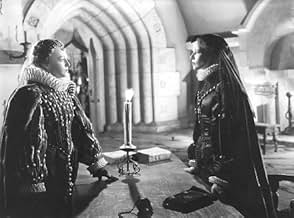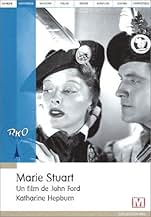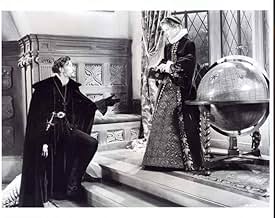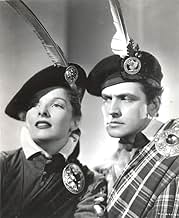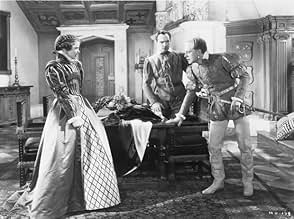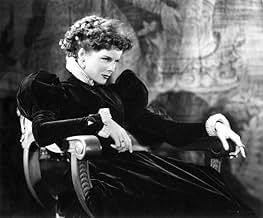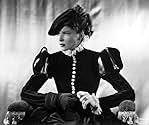NOTE IMDb
6,3/10
2,9 k
MA NOTE
Marie Stuart, récemment devenue veuve, retourne en Écosse pour reprendre son trône, mais elle se heurte à l'opposition de son demi-frère et de ses propres seigneurs écossais.Marie Stuart, récemment devenue veuve, retourne en Écosse pour reprendre son trône, mais elle se heurte à l'opposition de son demi-frère et de ses propres seigneurs écossais.Marie Stuart, récemment devenue veuve, retourne en Écosse pour reprendre son trône, mais elle se heurte à l'opposition de son demi-frère et de ses propres seigneurs écossais.
- Réalisation
- Scénario
- Casting principal
- Récompenses
- 3 victoires et 1 nomination au total
Avis à la une
Don't let my summary get you upset, I would never mean to do that--but although I do love this film--in short it is a bit boring. I loved the period costumes and sets and the acting, but the storyline lacked any real excitement!! Hepburn was fine but any real passion in the acting department has to go to Fredric March. The supporting players were also very good in their parts, especially Florence Eldridge as Queen Elizabeth. I saw somewhere that Ginger Rogers tried out secretly for the role of Elizabeth and almost had it until she was found out by the director!! Would have loved to have seen that one--LOL But it is a nice film, but just a tad too long and boring!!
The complicated historical background involved in MARY OF Scotland is such that unless you know something about British monarchs you'll have a hard time knowing where the truth lies in this epic historical romance. But it's clear that KATHARINE HEPBURN gives a radiant performance as Mary, Queen of Scots--the only drawback being that she never ages a bit over a twenty-five year span. When she goes to her execution, she looks just as young as she did in the opening scene.
It's a pleasure to report that FREDRIC MARCH breathes a lot of life into his portrayal of Bothwell. Too bad he didn't exhibit this kind of gusto when he played the title role in ANTHONY ADVERSE the same year. He's all bravado and robust athletic grace and looks good in his period costumes. Maybe we owe his strong performance to John Ford, but whatever it is, he's much better here than he was as Anthony Adverse.
JOHN CARRADINE seemed an unusual choice to play Rizzo, the Italian secretary who happens to be a troubadour of sorts, but it's nice to see him in a more sympathetic role for a change. DONALD CRISP, ALAN MOBRAY, DOUGLAS WALTON and FRIEDA INESCOURT are interesting in supporting roles.
Walton is another actor who shines here, rather than remaining colorless in the background of many a film. He gives a flamboyant performance as Lord Darnley and it's probably among the best roles he ever had.
FLORENCE ELDRIDGE makes an interesting Queen Elizabeth, less showy in the role than Bette Davis or Flora Robson but still with the right amount of regal spirit.
John Ford directs the first half of the film with his usual authority but things get a little too repetitious and slow-moving in the second half when tedium really settles in before Mary's final walk to the execution block.
Summing up: A mixed bag, some strong performances, a few strong scenes but overall result is disappointing. Here's an historical romance that cried out for Technicolor. It manages to look drab in B&W despite the lavish costumes and good photography.
It's a pleasure to report that FREDRIC MARCH breathes a lot of life into his portrayal of Bothwell. Too bad he didn't exhibit this kind of gusto when he played the title role in ANTHONY ADVERSE the same year. He's all bravado and robust athletic grace and looks good in his period costumes. Maybe we owe his strong performance to John Ford, but whatever it is, he's much better here than he was as Anthony Adverse.
JOHN CARRADINE seemed an unusual choice to play Rizzo, the Italian secretary who happens to be a troubadour of sorts, but it's nice to see him in a more sympathetic role for a change. DONALD CRISP, ALAN MOBRAY, DOUGLAS WALTON and FRIEDA INESCOURT are interesting in supporting roles.
Walton is another actor who shines here, rather than remaining colorless in the background of many a film. He gives a flamboyant performance as Lord Darnley and it's probably among the best roles he ever had.
FLORENCE ELDRIDGE makes an interesting Queen Elizabeth, less showy in the role than Bette Davis or Flora Robson but still with the right amount of regal spirit.
John Ford directs the first half of the film with his usual authority but things get a little too repetitious and slow-moving in the second half when tedium really settles in before Mary's final walk to the execution block.
Summing up: A mixed bag, some strong performances, a few strong scenes but overall result is disappointing. Here's an historical romance that cried out for Technicolor. It manages to look drab in B&W despite the lavish costumes and good photography.
This is a good costume-designing , historic-drama and Katherine Hepburn is well cast in the title role . She plays a tragic , romantic heroine that contends with various treacheries . Mary (1516-1558) inherited the throne of Scotland from Jacob V . She was next in line to the English kingdom , and married Francisco II , king of France , but he died early . Having been in France for thirteen years , Mary returned Scotland , and arrives from France with some misgivings . Then , Mary disembarks in Leith and goes to a castle near Edimburg , along with David Rizzio (a cadaverous John Carradine) , court musician and confidant . There , she's received by his brother , the Earl James Stuart , (Ian Keith) . Later on , Queen Mary married a foppish named Lord Darnley (Walton) . But Mary falls in love with Bothwell (a stylish Fredric March) , a kilted Earl and her supporter in her battle for power . Then , Rizzio was reputed to be the father of Mary's , the future James I of England . Darnley , with some underlings , murdered Rizzio in Mary's presence . But Darnley is killed by an explosion in his refuge , outskirts Edimburg , and the God-fearing Calvinists led by John Knox (Moroni Olsen who played same role in stage) accused to Bothwell as regicide . John Knox and the rebels Lords besiege Holyrood and the Borthwell's stronghold , Dumbar castle . The Calvinists forced her abdication , Mary escapes and asks for protection to Queen Elizabeth I (Florence Eldridge) , but Mary is double-crossed and is taken imprisoned in the Tower of London . Although supposedly Mary and Elizabeth never met face to face , the movie have them doing so and the screen crackle when both have their reunion , because they are strong rivals for power in Tudor dynasty , England . After that , Mary confronts her English accusers at court in a stylized trial . Finally , the film reflects splendidly when Mary goes to beheading block with all due pomp and circumstance .
The motion picture is finely performed by Katharine Hepburn, in spite of this she was in her ¨box-office poison¨ days , the last scenes , where Mary confronts trial is so well played and photographed in a stylized manner -with Mary on the floor and judges in a sort of balcony- by cameraman Joseph August . However , the picture is interminable and overlong and some moments is frankly boring . Writing credits with excessive speeches by Maxwell Anderson (his own playwright) and Dudley Nichols , a Ford's habitual screenwriter . The picture is lavishly produced by Pandro S. Berman , an usual costumer's producer and professionally directed by John Ford . Followed by a remake with the same title (1971) with Vanessa Redgrave as Mary and Glenda Jackson as Elizabeth and directed by Charles Jarrott .
The motion picture is finely performed by Katharine Hepburn, in spite of this she was in her ¨box-office poison¨ days , the last scenes , where Mary confronts trial is so well played and photographed in a stylized manner -with Mary on the floor and judges in a sort of balcony- by cameraman Joseph August . However , the picture is interminable and overlong and some moments is frankly boring . Writing credits with excessive speeches by Maxwell Anderson (his own playwright) and Dudley Nichols , a Ford's habitual screenwriter . The picture is lavishly produced by Pandro S. Berman , an usual costumer's producer and professionally directed by John Ford . Followed by a remake with the same title (1971) with Vanessa Redgrave as Mary and Glenda Jackson as Elizabeth and directed by Charles Jarrott .
Katharine Hepburn plays the young queen in this John Ford version of the rivalry between Mary of Scots and her cousin, Elizabeth I (played by Florence Eldridge; whose husband Fredric March plays a jaunty Lord Bothwell). Cut back to the bare bones, and squarely on the differences between the two women, it isn't altogether successful.
John Knox rants his Protestant spiel, Bothwell appears with a retinue of pipers (at several points); Darnley's murder is glossed over, as is his smallpox. John Carradine has a well-defined role as the ill-fated David Rizzio, while Mary's parasitical court of Lords are quirkily represented and dismissed.
Hepburn isn't as bad as one would fear, but it wasn't really a suitable role for her, nor, one would expect, was the material enough for tough director Ford to make much of. So this film remains a misfire, with some interesting sequences and some strong performances, but as a whole, it just doesn't work.
John Knox rants his Protestant spiel, Bothwell appears with a retinue of pipers (at several points); Darnley's murder is glossed over, as is his smallpox. John Carradine has a well-defined role as the ill-fated David Rizzio, while Mary's parasitical court of Lords are quirkily represented and dismissed.
Hepburn isn't as bad as one would fear, but it wasn't really a suitable role for her, nor, one would expect, was the material enough for tough director Ford to make much of. So this film remains a misfire, with some interesting sequences and some strong performances, but as a whole, it just doesn't work.
There was something of a fad for Tudor-period dramas in the late 1930s, although Mary of Scotland is something of an overlooked picture in the careers of Katherine Hepburn and John Ford. The star and director went on to have an on-off love affair, although this was the only occasion on which they worked together.
Mary of Scotland has the look that is typical of Ford's RKO features. It's often forgotten that Ford was a director who liked to work with space, shape and light, usually manifested in a sharp contrast between the indoor and outdoor worlds. Here the contrast is between the palace of Elizabeth – light, open and filled of straight lines and symmetry – and the castle of Mary – small, shadowy and made of rough curves. At first glance this seems to imply that the Scottish setting is grimmer and more confined, but for Ford these cosy spaces with layers of shadows were also about honesty and simplicity – see for example the compositions he makes in The Informer or The Fugitive. Those two pictures were also made at RKO, and their expressive look is testament to the fact that although the studio might not have had much money it did have a strong and open-minded production design team, something Ford took advantage of when he could.
By this point, few Ford films would be complete without the sing-song scene, and there is an especially fine example in Mary of Scotland. Ford never made an out-and-out musical in his career, but the way he uses singing as an emotional backdrop is remarkable. Here, the song sung by the peasants as they march into the castle begins as a simple yet effective expository device – demonstrating where the people's loyalties lie – but then the scene moves onto another level. Ford isolates one singer, then cuts to a rare close-up of Hepburn. The beauty of the music provides a backdrop to her emoting. It is in such moments that Ford's direction is at its strongest.
This was perhaps an important breakthrough role for Hepburn, whose parts until now had mostly been as teenagers or young women. This is her first real adult role and she handles it well, albeit with one or two touches of uncertainty when she is required to act "queenly". She does however manage the task of humanising the queen, more so than the screenplay would seem to allow. Unfortunately her leading man, the normally excellent Fredric March, is rather bland here. It's a real treat though to see John Carradine in a role where he really gets to show his more sensitive side. Because of his looks, not to mention his creepy voice, the character actor generally landed villainous roles, but he was actually at his best playing good guys.
One oft-repeated story regarding this production – although it varies a little depending on who's telling it, so pinches of salt at the ready – is that Hepburn and Ford disagreed over the necessity of Mary and Bothwell's final scene together on the tower top. Ford thought it a pointless bit of soppiness, Hepburn said it was the most important scene in the script. Eventually a flippant Ford challenged Hepburn to direct it herself, which she did. The scene stands out because Hepburn actually shoots it with some romantic tenderness – something Ford hardly ever did – with lengthy close-ups and rhyming angles. You can see why Ford didn't like it; he tended to downplay the love themes in his pictures, and on top of that the scene is rather heavy on dialogue. Hepburn was right though – without this scene the romance between Mary and Bothwell would be little more than a subplot, and without the romance the film wouldn't work. Audiences would find it hard to empathise with a queen clinging onto her throne, but easy to sympathise with a woman separated from the man she loves.
Mary of Scotland was not really Ford's cup of tea, and it was his rather cavalier approach to interpreting a screenplay that spoiled a fair few of his pictures (even though it won him the admiration of the auteurists). This picture is only saved by his use of music, the proficiency of the RKO crew and of course the good judgement of Katherine Hepburn. Nevertheless, I can't help but love Ford's laid-back realism. In one scene, we see a dog barking crazily at men entering a room; in another a moth flutters about John Knox's head. How many other directors of that era would have kept those takes?
Mary of Scotland has the look that is typical of Ford's RKO features. It's often forgotten that Ford was a director who liked to work with space, shape and light, usually manifested in a sharp contrast between the indoor and outdoor worlds. Here the contrast is between the palace of Elizabeth – light, open and filled of straight lines and symmetry – and the castle of Mary – small, shadowy and made of rough curves. At first glance this seems to imply that the Scottish setting is grimmer and more confined, but for Ford these cosy spaces with layers of shadows were also about honesty and simplicity – see for example the compositions he makes in The Informer or The Fugitive. Those two pictures were also made at RKO, and their expressive look is testament to the fact that although the studio might not have had much money it did have a strong and open-minded production design team, something Ford took advantage of when he could.
By this point, few Ford films would be complete without the sing-song scene, and there is an especially fine example in Mary of Scotland. Ford never made an out-and-out musical in his career, but the way he uses singing as an emotional backdrop is remarkable. Here, the song sung by the peasants as they march into the castle begins as a simple yet effective expository device – demonstrating where the people's loyalties lie – but then the scene moves onto another level. Ford isolates one singer, then cuts to a rare close-up of Hepburn. The beauty of the music provides a backdrop to her emoting. It is in such moments that Ford's direction is at its strongest.
This was perhaps an important breakthrough role for Hepburn, whose parts until now had mostly been as teenagers or young women. This is her first real adult role and she handles it well, albeit with one or two touches of uncertainty when she is required to act "queenly". She does however manage the task of humanising the queen, more so than the screenplay would seem to allow. Unfortunately her leading man, the normally excellent Fredric March, is rather bland here. It's a real treat though to see John Carradine in a role where he really gets to show his more sensitive side. Because of his looks, not to mention his creepy voice, the character actor generally landed villainous roles, but he was actually at his best playing good guys.
One oft-repeated story regarding this production – although it varies a little depending on who's telling it, so pinches of salt at the ready – is that Hepburn and Ford disagreed over the necessity of Mary and Bothwell's final scene together on the tower top. Ford thought it a pointless bit of soppiness, Hepburn said it was the most important scene in the script. Eventually a flippant Ford challenged Hepburn to direct it herself, which she did. The scene stands out because Hepburn actually shoots it with some romantic tenderness – something Ford hardly ever did – with lengthy close-ups and rhyming angles. You can see why Ford didn't like it; he tended to downplay the love themes in his pictures, and on top of that the scene is rather heavy on dialogue. Hepburn was right though – without this scene the romance between Mary and Bothwell would be little more than a subplot, and without the romance the film wouldn't work. Audiences would find it hard to empathise with a queen clinging onto her throne, but easy to sympathise with a woman separated from the man she loves.
Mary of Scotland was not really Ford's cup of tea, and it was his rather cavalier approach to interpreting a screenplay that spoiled a fair few of his pictures (even though it won him the admiration of the auteurists). This picture is only saved by his use of music, the proficiency of the RKO crew and of course the good judgement of Katherine Hepburn. Nevertheless, I can't help but love Ford's laid-back realism. In one scene, we see a dog barking crazily at men entering a room; in another a moth flutters about John Knox's head. How many other directors of that era would have kept those takes?
Le saviez-vous
- AnecdotesKatharine Hepburn credited John Ford with saving her life one day on the set. They were shooting a scene of Hepburn on horseback when the horse she was riding kept going unexpectedly. Ford yelled at Hepburn to duck just before she was about to collide with a low branch.
- GaffesMary's execution takes place outdoors. It actually took place in the great hall of Fotheringay Castle.
- Citations
Mary, Queen of Scots: [to Queen Elizabeth I] I might have known you'd come to gloat like this - stealthily, under cover of night.
- Crédits fousOpening credits: "Like two fateful stars, Mary Stuart and Elizabeth Tudor appeared in the sixteenth century, to reign over two great nations in the making ... They were doomed to a life-and-death struggle for supremacy, a lurid struggle that still shines across the pages of history ... But today, after more than three centuries, they sleep side by side, at peace, in Westminster Abbey."
ENGLAND
- Versions alternativesExists in a computer-colorized version.
- ConnexionsFeatured in The Costume Designer (1950)
Meilleurs choix
Connectez-vous pour évaluer et suivre la liste de favoris afin de recevoir des recommandations personnalisées
- How long is Mary of Scotland?Alimenté par Alexa
- What is 'Mary of Scotland' about?
- Is "Mary of Scotland" based on a book?
- Who is Mary of Scotland?
Détails
- Date de sortie
- Pays d’origine
- Langue
- Aussi connu sous le nom de
- María Estuardo, reina de Escocia
- Lieux de tournage
- Société de production
- Voir plus de crédits d'entreprise sur IMDbPro
- Durée2 heures 3 minutes
- Couleur
- Rapport de forme
- 1.37 : 1
Contribuer à cette page
Suggérer une modification ou ajouter du contenu manquant

Lacune principale
By what name was Marie Stuart (1936) officially released in India in English?
Répondre

